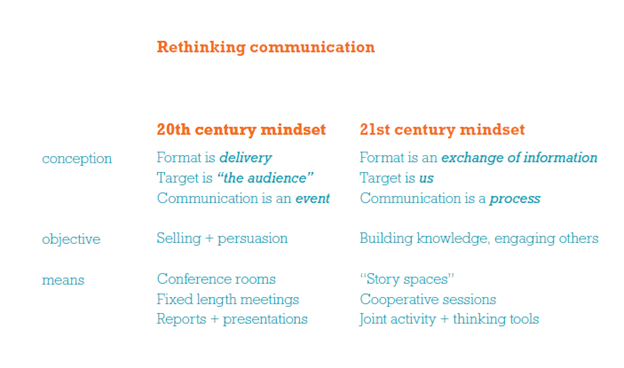We’ve all seen the movies in which the hero or heroine comes up with a brilliant idea to solve a pressing problem, the idea gets immediate opposition, the lead persists in the idea and then the brilliant idea ends up saving the day. It’s a great movie plot but like most movie plots, it doesn’t really resemble real life situations. More often in the real world, people come up with great ideas and others nod along but when everybody walks out of the meeting or closes their email, the great idea goes no further.

Source: Erwin, Kim. 2014. Communicating the New: Methods to Shape and Accelerate Innovation. Hoboken, New Jersey: Wiley.
In today’s environment and its increasing levels of volatility, uncertainty, complexity and ambiguity (VUCA), the process of moving from ideas to action is no longer linear. Engagement is not something that happens after a big idea: It occurs iteratively throughout the process. We must see communication as a process and not an event and we must understand that communication is inextricably linked with co-construction of ideas and building engagement.
Our language can keep us in that older mindset. We talk about “selling an idea” but ideas aren’t products. Instead, ideas are created and recreated as they are transferred from person to person and whether they succeed or fail depends on how people engage with ideas and with the process as a whole. Our new realities mean that people need to be engaged from the beginning. This requires understanding change as well as communication.
Early stakeholder engagement has many benefits. One main benefit is that continuous engagement can help identify barriers to moving the idea forward.
Change management theory describes three gaps between ideas and change.
• Awareness: I’ve not heard the new idea or I don’t understand it.
• Agreement: I’ve heard the idea and I understand it but I disagree with it.
• Ability: I agree with the idea but I’m not able to implement it.
By knowing the kind of barriers an idea may encounter, a team can employ methods to address them before the idea is fully formed and before they block action.
The contemporary communications plan that treats communication as a process and co-construction as part of that process can bridge all of these gaps.
By knowing the kind of barriers an idea may encounter, a team can employ methods to address them before the idea is fully formed and before they block action.
The contemporary communications plan that treats communication as a process and co-construction as part of that process can bridge all of these gaps.
Source: Erwin, Kim. 2014. Communicating the New: Methods to Shape and Accelerate Innovation. Hoboken, New Jersey: Wiley.
Learn More at the SHSMD Annual Conference
The
“Designing For Change: Use Design Thinking to Align Teams, Fortify Ideas And Prepare The Organization To Execute” workshop at SHSMD Connections 2019, with Kim Erwin and Sarah Norell, will introduce you to the new thinking and new principles for leading people-centered change. You’ll learn about turning communication into a process, understand the design methods that drive successful engagement with ideas and become a more successful communicator, coalition builder and leader of change.
The workshop will be one of a broad range of educational sessions offered at the conference designed to position SHSMD members for success in the new health care landscape.